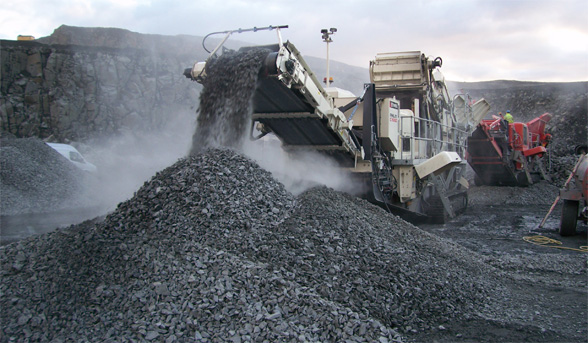In the world of mining, quarrying, and construction, impact crushers play a crucial role in breaking down large rocks and materials into smaller, more manageable sizes. These powerful machines are essential for producing aggregates, crushed stones, and other materials used in infrastructure projects. To ensure the utmost productivity and cost-effectiveness, focusing on optimizing impact crusher performance, particularly in terms of crusher wear part optimization, is essential. In this article, we will delve into the strategies and techniques that can help you maximize the efficiency of your impact concrete crusher.
Understanding Impact Crushers
Before we dive into optimization strategies, let’s briefly understand how impact crushers work. An impact crusher is a heavy-duty machine that uses a high-speed rotor to impact materials, causing them to break into smaller pieces. This process is achieved by colliding the material with the rapidly rotating hammers or blow bars on the rotor. The crushed material is then discharged through an opening at the bottom, typically onto a conveyor belt for further processing.
Impact crushers are versatile machines capable of handling various types of materials, including limestone, granite, concrete, and more. However, several factors can influence their performance, with crusher wear parts being one of the most critical components.
Importance of Crusher Wear Part Optimization
Crusher wear parts, including blow bars, impact plates, and liners, are subject to constant wear and tear during crushing. Over time, these parts can become worn down, affecting the crusher’s overall performance. Here’s why optimizing these wear parts is crucial:
- Maintaining Efficiency: As wear parts degrade, the crusher’s ability to crush materials efficiently diminishes. This can result in reduced throughput, increased energy consumption, and higher operating costs.
- Quality of Output: Worn wear parts can lead to poor product quality with excessive fines or unevenly crushed material. This can affect the final product’s suitability for its intended application.
- Downtime and Maintenance Costs: Neglecting wear parts can lead to more frequent breakdowns and downtime for maintenance and replacement. This can disrupt production schedules and increase maintenance costs.
Now that we understand the significance of crusher wear part optimization, let’s explore several strategies to enhance the performance of your impact crusher.
1. Regular Inspection and Maintenance
The first step in optimizing your impact crusher’s performance is establishing a routine inspection and maintenance schedule. Regularly inspecting wear parts, such as blow bars and liners, allows you to identify signs of wear and replace them before they significantly affect performance. Scheduled maintenance not only prevents unexpected breakdowns but also extends the lifespan of your equipment.
2. Choose the Right Wear Parts
Selecting the appropriate wear parts for your specific application is crucial. Different materials and operating conditions require different types of wear parts. Work closely with your crusher manufacturer or supplier to choose wear parts designed to withstand your operation’s demands. High-quality wear parts may have a higher initial cost but can result in long-term savings through improved performance and durability.
3. Optimize Rotor Speed and Configuration
The rotor plays a pivotal role in an impact crusher’s performance. Adjusting the rotor speed can significantly impact the machine’s output and product quality. Faster rotor speeds typically result in finer product sizes, while slower speeds may produce coarser materials. Experiment with different rotor configurations and speeds to find the optimal settings for your desired output.
4. Monitor Feed Size and Gradation
The size and gradation of the feed material have a direct impact on crusher performance. Ensure the feed material is within the specified size range and has a consistent gradation. Irregularly sized or poorly graded material can lead to uneven wear on wear parts and reduced efficiency.
5. Maintain Proper Clearances
Proper clearance settings between the rotor and impact aprons or between the rotor and blow bars are essential for optimal crushing performance. Incorrect clearances can result in uneven wear and reduced efficiency. Regularly check and adjust these clearances to ensure consistent and efficient crushing.
6. Implement a Wear Part Monitoring System
Incorporating a wear part monitoring system can provide real-time data on the condition of critical components. These systems use sensors to track wear part performance and can alert operators when it’s time for a replacement. Implementing such a system can help you proactively address wear issues and minimize unplanned downtime.
7. Training and Education
Invest in training for your operators and maintenance personnel. Well-trained staff can identify wear-related issues early, operate the crusher more efficiently, and perform routine maintenance effectively. Additionally, they can make informed decisions when it comes to adjusting settings and replacing wear parts.
Future Trends in Impact Crusher Technology
As technology continues to advance across various industries, the field of impact crushers is no exception. In the coming years, several exciting trends and innovations are expected to shape the future of impact crusher technology, further enhancing their efficiency and environmental sustainability.
- Automation and Smart Control: Future impact crushers will likely incorporate advanced automation and control systems. These systems can optimize crusher settings in real-time, adjusting parameters such as rotor speed, feed rate, and chamber configuration to maximize efficiency and minimize wear.
- Energy Efficiency: Energy consumption is a significant concern in crushing operations. Future impact crushers will focus on improving energy efficiency through innovations like regenerative braking systems and more efficient motor designs.
- Hybrid and Electric Crushers: The industry is moving toward hybrid and electric crushers to reduce carbon emissions and operational costs. These machines will run on a combination of electric power and traditional fuel sources, reducing environmental impact.
- Advanced Materials: Manufacturers will continue to develop wear-resistant materials for impact crusher components, extending their lifespan and reducing the need for frequent replacements.
- Data Analytics and Predictive Maintenance: Advanced data analytics and predictive maintenance algorithms will become integral. These technologies will monitor equipment health in real-time, predict maintenance needs, and reduce downtime.
- Modular Designs: Future crushers may adopt modular designs that allow for easy customization and upgrades, making them more adaptable to changing requirements.
- Improved Safety Features: Safety will remain a top priority, with advancements in safety features and technologies to protect operators and maintenance personnel.
In summary, the future of impact crusher technology is set to be driven by automation, energy efficiency, environmental sustainability, and safety. These innovations will improve performance, reduce operational costs, and contribute to a more sustainable and efficient mining and construction industry.
Conclusion
Optimizing the performance of your impact crusher is essential for maximizing efficiency and productivity in your mining, quarrying, or construction operation. Focusing on crusher wear part optimization is key to this process, as it directly impacts efficiency, product quality, and maintenance costs.
By implementing regular inspection and maintenance practices, choosing the right wear parts, optimizing rotor speed and configuration, monitoring feed size and gradation, maintaining proper clearances, and utilizing wear part monitoring systems, you can ensure that your impact crusher operates at its best. Furthermore, investing in training and education for your personnel will empower them to make informed decisions and contribute to the long-term success of your operation.
In conclusion, a well-maintained and optimized impact crusher can be a valuable asset that contributes to the success and profitability of your business while minimizing operational costs and downtime. Prioritizing crusher wear part optimization is a step in the right direction toward achieving these goals.

